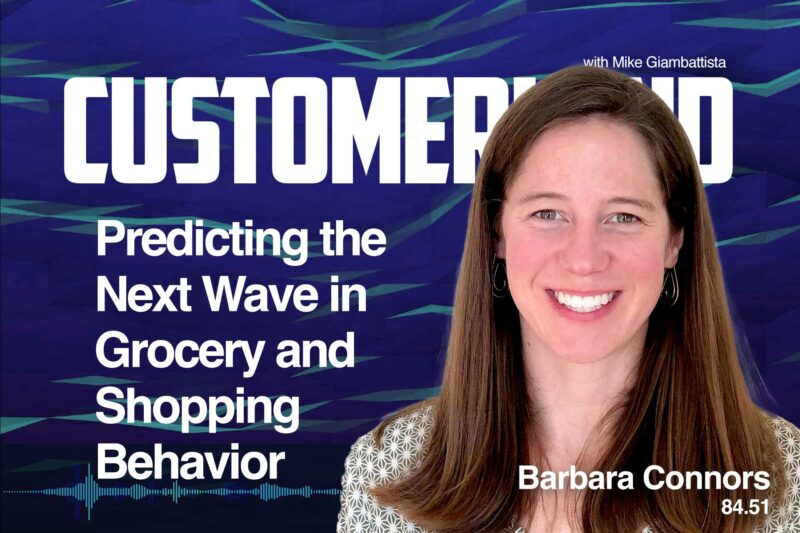Discover the future of consumer shopping habits and strategy adaptation with Barbara Connors, Vice President Strategy and Acceleration at 84.51. As we unpack the lessons from their 2023 year in review report, you’ll see the critical role of customer engagement and the significance of shifting strategies in our unpredictable economic climate. Whether it’s the impact of SNAP benefit changes or the ripple effects of global conflicts, we delve into how businesses need to be ready to pivot. With 84.51’s prowess in using first-party data to enhance retail decisions, Barbara sheds light on how consumer challenges, especially those brought on by inflation, are reshaping the need for solutions rooted in data.
The dance between consumer behavior and brand loyalty gets complicated when prices escalate. Barbara and I dissect the methods consumers use to stay loyal to their favorite brands without emptying their wallets. We examine the innovative tactics they adopt, from bargain hunting to embracing private labels, and how these choices vary across different demographic groups. Personalized promotions and digital media emerge as essential tools for keeping customers from straying, and we share insights on how brands can decode and respond to these complex consumer behaviors.
To cap off our conversation, we gaze into the crystal ball of shopping’s future, contemplating the emergence of ‘hybrid shoppers’ who blend digital convenience with the in-store experience. We muse over the impact of technologies like smart carts and the timeless appeal of in-store sampling, exploring how retailers can balance consumer economic concerns with the desire for delightful shopping encounters. This episode is a treasure trove of wisdom for anyone interested in the nexus of CPG, grocery retail, and customer experience—and with Barbara’s expertise, we ensure you’re at the forefront of this evolving landscape.
Read the full transcript below
Barbara Connors
Reminder that, as you are building strategies to connect with customers in a different way next year, that you are continuing to pulse with them throughout the year on where they are at, because one of the biggest learnings we’ve had over the last several years is that things change quickly, and this year there were several things that happened from a macroeconomic standpoint Think SNAP benefits getting called back, student loan repayments coming back. You had global wars. Pick up that. The assumptions that you make going into the year and the plans that you build will have to be revisited at a more frequent basis, and they should be revisited by focusing on what customers are telling you is most important to them.
Mike Giambattista
Welcome Barbara Connors, who is Vice President Strategy and Acceleration at 84.51. Really excited to talk about 84.51’s latest report, which is the 2023 year in review. They’re findings because there are some surprises in there, but first, thanks for doing this. Really appreciate it, Barbara.
Barbara Connors
Thank you so much for having me.
Mike Giambattista
I’m a big fan of yours. I think most of the people listening to this will have some idea what 84.51 is all about, but maybe, if you would mind, tell us as a reminder what 8451 does, where you operate and your role there.
Barbara Connors
Yeah. So 84.51 is a retail data, science, insights and media company. It’s a very, very wholly owned subsidiary of Kroger and we work with both the Kroger company and consumer packaged goods and agencies and retail partners to leverage really the host of our assets that are all built on top of Kroger’s first party customer data to connect with customers in a better way, and that is across all the decisions they make around what goes on shelf price and promotion assortment, as well as how they connect with customers direct through coupons and the loyalty program and through advertising now as well. The big three arms that we engage with the CPG community with is our insights business, loyalty business and now with retail media program, precision marketing.
Mike Giambattista
Okay, and so your function within 84.51 is glue between all of those functions, or A little bit, yeah.
Barbara Connors
So I laid strategy and acceleration. So I have a couple of different centers of excellence we will. One is thought leadership and industry engagement. So the reports, like what we’ll talk about today, are generated really to drive a better understanding of what’s happening for the customers that we are all collectively serving, so that we can all be more data driven and pointed and how we engage with them, and that impacts all of our businesses. I also lead a team that we call a merch all profit collaboration. So across the Kroger enterprise there is a lot of engagement and collaboration that happens with the CPG community. So I also have a team that acts as a bit of a glue between the those two sides of our businesses as well.
Mike Giambattista
Interesting. I’ve spoken with a handful of your colleagues before. It’s always fascinating, always enlightening. I want to add a little bit of context and editorialize here, just to hear before we even get into this. So it’s year end, everybody’s making predictions, everybody’s coming out with reports. I think personally I would say not just we, but me specifically I tend to pay most attention to the reports that come from entities that are operating squarely within the consumer insight space, for whatever vertical or segment they’re addressing, and 8451 is certainly one of those. So there’s a lot to unpack here. There’s a lot of I’m just use the word gravity behind it, because 84.51 genuinely knows what they’re talking about.
Barbara Connors
Thank you for that. At least I’m pretty sure that anyway or tenant of our business models, being focused on the customer. That comes from really listening to them and understanding what their motivations are, what their anxieties are, motive, what is changing for them, so that we can respond with them at the heart of all our decisions.
Mike Giambattista
Let’s talk about the report a little bit. I’ve been through it, I’ve pulled out a handful of highlights. I think you’ve probably got some of your own, but I think maybe it would be helpful to begin the conversation just to unpack what’s changed, what are the big changes, and then we maybe go specifically and drill down to each one of them.
Barbara Connors
Yeah, so one of the biggest changes that happened throughout the course of this year was the sustained impact of inflation. We have been monitoring customer response to it, concern around all the macro-economic factors that are impacting them over the last few years and this year, as you talk about the gravity, it’s just the weight of the sustained nature of pressures and really this year what we saw even grow throughout the years increasing of uncertainty around how long it will last If we are going to move into a recession, how quickly that will be. So I’d say the big change this year is just the heaviness that these changes that have been impacting customers the last couple of years likely aren’t going away anytime soon and there’s uncertainty around how long it will really last. So there’s been a lot of on the positive side than creativity and resilience around how to then adapt to what is anticipated to be some sustained changes for customers.
Mike Giambattista
So there’s a lot in the news right now about the inflationary pressures, but the weird kind of clash between the genuine pressures that consumers are feeling because of inflation and related but their spending habits in certain sectors really haven’t responded in ways that you would expect and I think I forget honestly I forget which sectors I was just reading about, but some sectors are actually doing quite well right now when normally under these kinds of circumstances they wouldn’t In your world. Are you seeing consumers respond in a way that you would expect them to to these pressures?
Barbara Connors
At a high level. Yes, what is the top behavior that has been exhibited by customers across demographic groups? Price sensitivity is looking for sales deals and coupons more frequently. So within that, what that says is, to your point customers don’t want to change what they are buying. If you are loyal to a brand and you have a particular repertoire of what you put in your basket every week, based on your meal plan and your family’s lifestyle, you don’t want to change that. So by looking for sales deals and coupons more frequently, you’re able to stretch your dollars without sacrificing what it is that you buy. So that is by far the number one behavior that we are seeing customers take, and that’s throughout the year.
Where there are differences is where you see the different constraints that different groups of customers have and, based on the different constraints that you have, you’re then able, as an individual, to pull different levels within your own budget. So we see conflicting behaviors around pack size. As an example. You have some customer groups that are saying I’m actually going to save more because I’m going to buy more in bulk. I’m going to plan ahead and not only buy in bulk. I’m going to buy in bulk to then repackage into smaller packages for my family. You then have other customer groups that can’t do that. You are on more of a fixed budget and so you have had to shrink your pack size in order to get the products that you want in your basket.
So your question around is it what you would expect? Is a little bit tricky, because when you think back on it you’re like, why would expect that you’re going to have those different levers that exist? It makes it more difficult when you’re trying to look for macro trends and movements and customer behavior, because within that you’re going to see those two things wash out in the data If you don’t look at it from a customer lens and really tease out those nuances to see actually it isn’t flat. We have some people that are buying the bulk, some people that are a Shreve, compact size, and if you were to look at the averages you might see it. You might miss that nuance.
We also see the same thing happen when you think about trading to private label brands or just trading to lower cost brands. Period, there are, at a high level, certain categories where we see that customers are more willing to trade, trade down and switch brands than others, and I think the categories where people are really unwilling to or much less willing to trade to another brand, are things like packed care and baby care. Think of these things. Like you, you don’t want to upset the tummies of the loved ones that you have.
Mike Giambattista
Right, the people beings you care about the most.
Barbara Connors
So you were much less likely to trade to another brand. But there are also some interesting things in there where we also see that beverages, entering as an example, is another category of people are less likely to trade. That is actually more of an impulse category. You would think that that could be a category where you’re more willing to trade around, but it’s a category that has really built a lot of brand loyalty with customers. So you see the power of brand loyalty persisting in an environment like this, because in those categories that have historically done just a really good job because of the brands that have built connections with the customers that they’re also holding on, categories where customers are more willing to trade around are shelf-stable goods, even over-the-counter medicine, where customers are saying you know what?
I actually find that the quality can be pretty similar and if I trade to private label brands, I actually don’t feel like I’m sacrificing much in that decision. And so the risk there to brands, national brands in that space is you could lose those customers. They may switch and say I actually won’t go back. This isn’t a short-term switch I’m making. So when you think about the long-term changes that we see, I think that’s one of the trends that we’ll have to watch going into 24. And I’m sure national brands for sure are watching this because the risk of losing customers to private label brands is real and heavy for them.
Mike Giambattista
Is it too soon in this cycle to start talking about how CPGs and brands in general might respond to that trend? Because if these are brands you really genuinely care deeply about and there’s less of a tendency to switch, if you, on the other hand, have a portfolio of products that might be more considered commodity-type products and I’m thinking about what you just mentioned, the over-the-counter meds, like if we go to our local pharmacy, which shouldn’t remain unnamed. Their house label packaging is very, very, very similar to the main brand. I mean, they’ve designed this so that you really have to look twice or three times to distinguish which one you’re buying. So it makes that, I think, the whole psychology of a switch much easier, if that’s something you’re willing to consider because it looks like the same thing.
Barbara Connors
Yeah, it also makes it even more important for brands to be smart in how they execute promotion strategies and how they leverage digital media and retail media. And that is for two reasons. One is you can’t just be on promotion every day to combat customers from trading down. So you have to be really pointed at when you’re going to execute different promotions, how deep the frequency, breadth and depth that you’re going to execute to maximize the buy rate that you have, but then also leverage personalization, in a way to say I actually want to deliver different promotions to different customer groups because some customers are more important to me than others and I really don’t want to lose my most loyal shoppers. And with digital capabilities, with personalization and with advancements in retail media, you’re able to target the customers that matter most to you in a much more precise way than you could several years ago, to make sure that your dollars are being invested where it’s most impactful for you.
Sponsor Announcement: What Do Your Customers Expect of You?
What could you achieve if you knew what your customers expected ahead of time? What if you could know what customers expect by category and by brand 12 to 18 months ahead of traditional brand tracking methods? And what if you could know exactly where to adjust and where to spend in order to derive the most benefit every time.
A customer expectation audit allows you to identify areas that require strategic reinforcement, as well as pinpoint which values will contribute most to an emotional bond with your brand and optimize accordingly.
Customerland has partnered with Brand Keys, the world’s oldest loyalty focused consumer research firm, to bring real world customer expectation audits to brands, brand managers and to CX practitioners everywhere Want to know where your brand stands and exactly what to do about it. Go to expectationaudit.com and download a sample audit today.
Mike Giambattista
So maybe another conversation at a later date. I’m dying to get into Kroger’s 84.51’s retail media efforts and all of those insights and how you’re deploying them, because the whole thing is well. We’ll leave that for another conversation, but there’s an awful lot to talk about there. Let me get this conversation back on the original rails, which is you have some deep insights in the urine review special report. So, that said, I do want to get back on your schedule at some point and talk about retail media and what you’re doing there, but you know. Back to the issue of how brands are responding to some of these changes, anticipated changes. I guess my first question is do you feel like brands are aware of this trend that yet, and do you have a sense of how they are responding? Is there, is it time to sound the alarm and say, hey guys, there’s something happening here, or do you think most sophisticated brands already get that?
Barbara Connors
I think they are highly aware of the trends that are happening.
If you aren’t, you are not paying attention to customer insights. I think that the response and what we’re seeing there are two big things that I think are driving the challenge that is facing brands right now. One is maximizing your promotional dollars. So if you know that what customers are looking for sales deals, offers more frequently, you need to respond to that. But you have a limited budget to be able to do that. The other is navigating what is now happening in the trajectory of the inflated demand that happened in grocery as a result of the pandemic to what is a bit more of a normalization as we come out of it in 24. So it’s understanding both customer behavior as it responds to inflation and then also what are natural trends that are starting to move out of the pandemic. And be able to tease those two big things out, because that has very large implications in how you build out a strategy and expectations for the next fiscal year.
Mike Giambattista
So I like the way you’ve kind of framed that up from a customer standpoint. I’m going to paraphrase here, While concern over inflation has leveled out, shoppers are still feeling the pinch. They’re persevering with resilience, but unsure how long inflation will last. We talked a little bit about what that resilience might look like brand shifting into house brands and white labels. How else are these consumers persevering?
Barbara Connors
So we’ve seen different sort of creative ways in which customers are stretching budgets across different categories that I think, highlight perseverance and resilience. One is think about meat. So you think that the categories where customers have noticed increased prices most three quarters of customers at least noticed increased prices in dairy meat, seafood and produce. And if you think about what is core to your shopper basket, it is those categories.
You buy them every week. So, if you think meat as sort of one big example, there’s a host of behaviors that we’ve seen the customers have taken to respond to increased pricing, and some is short term and some is really creative and thinking about how you can make different lifestyle changes. So one is people saying, oh well, maybe I’ll change the cuts of meat that I’m buying his way to stretch my meal to use less meat. There’s also a trial of life based foods and different categories to try new recipes that actually just have less meat in them. So, as you think about the like, creativity and resilience, that’s just one example and one category.
That is a way in which customers are saying, hey, I guess there are tactical, short term things I can do to make this week’s trip the dollars I have to spend on it, go the furthest.
And there are also things that I can do that give me a new recipes in my toolkit and are increasing the variety of things that I eat, also helping me be healthier and what we’ve seen as one of the positive things that’s come out of this as well as, as I’m just saying, hey, there’s an opportunity for me to save while also reducing food waste and therefore also helping the environment and sustainability. So reduction in food waste has also been top of mind. For customers is I think about how can I make sure that I’m not buying food too much that’s going to waste in on my counter, my fridge, and then in doing so, I also feel good about the decisions that I’m making long term. So there are a whole host of different ways that customers are thinking about the constraints in front of them and being really creative and smart, and how, how you’re making the food waste of what is a difficult situation for money.
Mike Giambattista
So you just brought up a topic that I’m going to make the theme for our third installment of this conversation, which is how consumers are feeling about and dealing with issues of sustainability, because there’s a lot of talk about how important it is to brands to address that and there’s an awful lot of talk about how consumers say they feel about it but tend to act a little differently when it comes to making the purchases. So it will make that, you know, conversation number three here. So I’m going to read one of your highlights here and I love to unpack this a little bit. While COVID created a strong focus for on-shelf and in-stock fundamentals, supply chains have largely recovered. New preferences across categories and product attributes are starting to emerge. We all kind of thought that might happen, but you guys actually see the data. So what gives? What are some of those attributes and categories that are starting to emerge?
Barbara Connors
Yeah, and you know we can start to talk about some fun stuff. So when we think about categories or attributes that are popping for different customer groups, you can think about how brands can respond from an innovation standpoint, and there are some interesting things that we’re seeing both at the overall level and then also as you break down different age groups younger generation or generation. Overall we see increased focus on functional benefits so making sure that the stuff that I buy is helping me physically and also clean ingredients, which ties a little bit back to the discussion we’re having around sustainability, because it also just goes to just being able to understand what it is that I’m actually buying and eating. But there are some differences that we’re seeing that I think are pretty interesting across the age groups. So one that’s probably less surprising is, we think, older shoppers we still see low calorie, high fiber, sort of like key attributes that are popping.
Younger shoppers are actually seeing that non-alcoholic and functional beverages are attributes that are increasing, which has been an interesting trend overall that we’ve been seeing with younger shoppers.
That is, it ties a bit to the clean ingredients, but just sort of simplification as this overall sort of theme that can sort of connect all of these different attributes together is emerging as well, as you can then also think about the added layer this has on health. The evolving preferences or just nuances around health are also changing, and we’re seeing that shift by age group as well. Health has always been important, especially as we think about end of year and people are thinking about New Year’s resolutions. Every year, something pops saying I want to lead a healthier lifestyle. What is, I think, particularly interesting is that we see with these younger shoppers that some of the attributes around health that are popping are things like gut health and then also sleep and just overall well-being. So it is moving from calories, fiber, protein into sort of macro level or a broader definition of health. That, I think, will also see brands then respond to both in the innovation that comes, but also in how they speak about and communicate the innovation that they bring.
Mike Giambattista
That’s going to be a fun one to unpack in episode number four here when we do this again. There’s a lot to talk about. Clearly I would love to talk a little bit about as well about, I guess, your phrasing modalities how people are actually going about making these purchases, because all that’s changed. We have offerings now that didn’t exist even a year ago and much less five years ago. Forget about it. Everything’s changed there. But you track that Expectations versus realities, and how people are anticipated to respond and use these new channels. So can we talk about that a little bit? What are your understandings of modalities that work now, maybe grow or shift in importance in the future?
Barbara Connors
Yeah. So when we think about modalities, it’s the different methods. Through its few shocks, so big one thing in store shopping, your traditional shopping trip pickup, delivery and even ship. The big learning that we’ve had, and probably the industry at large as well, is that customers are not picking one or the other. We did not see the growth in e-commerce came in large part at the expense of in-store shopping. What it really meant was now customers have more options, so we think about them as being hybrid shoppers. So it’s shoppers that are more frequently using pickup for one trip, delivery for another, in-store for yet another.
Over the pandemic, certainly, e-commerce adoption skyrocketed, and it was mostly because of the beginning health. It then very quickly migrated into convenience. What we see as the top reason why customers are still choosing to go in store is that they don’t want someone else picking their groceries. So this is going to be the, I think, the biggest hurdle that retailers and brands have in the perimeter of the store. It is much easier when we see adoption happen first in center store, where you can pick up your box of cereal. Someone else can pick up your box of cereal, but there is still a preference for many to pick your own apples and your own bananas, and that is driving customers to continue to go in store.
Even as we ask younger shoppers. So we ask about what do you think about the shopping experience of the future and what do you want? What do you expect? Even within the youngest shoppers today, they expect in the future. 70% of them are still going to shop in store, so we are not expecting this full swing that today you have in-store shopping. In the future, it’s all going to move to e-commerce. It is really about adding options so that when someone wants delivery, you have that as an option for them, but thinking about it more as options rather than customers just secretly fitting into one bucket or the other.
We also see that the experiences or innovation, if you will that customers are asking for from in-store and e-commerce speak to the breadth of benefits that they want.
So on one hand, they say I want more digital capabilities in the store so I can get the benefits of what I do today shopping on e-com but I get it in store as well. So smart cards, as an example, if I want to be able to shop and I want to be able to track what I’m buying as I’m shopping, so it’s really easy for me to get in and out and I can get the benefit of e-com. We’ll still be able to pick what I want in the store, but we also see that still top among many is I want more sampling in store, which is not new and innovative, but it speaks to the experiential benefits that you can only deliver in a physical store. You cannot have someone try a new cookie online as they are browsing. It can only be done in store. So investment and innovation in the in-store experience and thinking about how you can blur digital and in-store and the best of both worlds is really where we see the future going, because shoppers are very clearly telling us that they want both.
Mike Giambattista
So to kind of put a nice bow around this yes, there’s a holiday reference there. How do you think CPGs brands retailers? Anyone who might be looking at this report should be thinking about and responding to these findings.
Barbara Connors
So what I hope that people looking at this do is focus on the customer and have a reminder that, as you are building strategies to connect with customers in a different way next year, that you are continuing to pulse with them throughout the year on where they are at, because one of the biggest learnings we’ve had over the last several years is that things change quickly, and this year there were several things that happened from a macroeconomic standpoint Think SNAP benefits getting called back, student loan repayments coming back. You’ve had global wars. Pick up that.
The assumptions that you make going into the year and the plans that you build will have to be revisited at a more frequent basis, and they should be revisited by focusing on what customers are telling you is most important to them, where there are areas of optimism and where they’re looking for fun and celebration and joy and lightness and impulse, and where they’re saying I have very real constraints and I need you to help me solve a real problem that’s in front of me.
And thinking about those two things as a way to sort of balance what is today a lot of heaviness, with also a desire to not get stuck in that and move back to a sense of normalcy and have the ability for brands to connect with customers in a way that provides some lightness and some attainable joy and treatment. Because in the grocery space, as you sort of opened it up with areas where customers are cutting back and spending more or less, these are not huge extravagant expenses the customers making the grand scheme of things within the grocery trip. You have a real opportunity to connect and provide some impulse and fun in a way that doesn’t break the bank for customers, and so there’s a real opportunity for brands to just focus on what matters most and deliver for customers that are most important to you.
Mike Giambattista
You heard it right here. I’m hoping that this generates a whole series of conversations. We’ll do what we have to do with our audience and listeners to do that, but there’s so much that we can pull apart just from that statement. What are those little fun, aspirational things look like? And there’s in CPG and grocery there are unique opportunities that don’t really exist in any other sectors to do that, just because of the nature of that shopping experience. So in any case, Barbara Connors, thank you so much for this. It’s enlightening. Every time I talk to somebody from 84.51, there are new light bulbs that start going off, and I think that’s the same for everybody who listens to this. So, and really very much looking forward to the next time, as we get to do it, because there’s a lot to talk about.
Barbara Connors
Thank you, looking forward to it.














